Methods for treating peonies from diseases and pests

Peonies are disease resistant crops, plants are able to grow in one area for decades and remain healthy. With improper care and mechanical damage, the immune system of peonies decreases, the flower becomes susceptible to infections and fungi. Frequent torrential rains and temperature changes are another hazard. In order to help the plant in time, it is necessary to recognize the disease at an early stage of development.
Causes and signs
It is worth paying attention to a description of the following signs of a variety of diseases:
- if the flowers grow poorly, the leaves curl, few buds form on the peony bushes, all this is evidence of the development of a culture disease or signs of devouring the plant by insects;
- the formation of black spots on the leaf plates of a peony serves as symptoms of the development of a viral or fungal disease that requires immediate treatment; this also includes the appearance of plaque, points of various shades;
- curling of leaves occurs due to the activity of a fungus or insects that feed on the intercellular sap of the plant; the affected leaves subsequently dry out and die off;
- if the crops do not bloom, the buds are deformed, not opened or covered with brown spots - you should carefully examine the plant for the presence of crawling insects, check the flower stems;
- the presence of swelling, dark spots on the shoots is a clear sign of the development of a fungus or a viral infection.
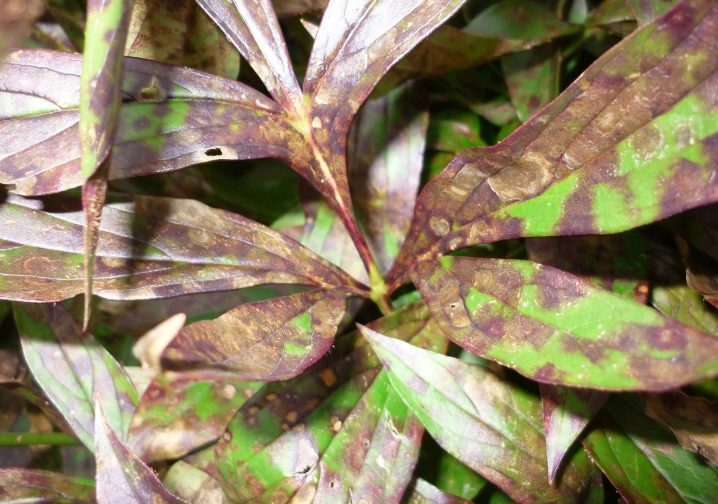
Common diseases
Diseases manifested by a change in the color of the leaves, causing various defects, are of genetic origin (hereditary) and external (infections, fungi).
Rust
Rust is caused by fungus. On the leaf plates of the culture, brown swellings are formed, spots of brown and brick-orange tones, surrounded by a dark border. All these formations are fungal spores. At the critical stage, the affected areas are combined, creating wide stripes. Due to rust, earnest plates turn yellow, wither, fall off.
The plant becomes incapable of photosynthesis, which will eventually lead to the death of the culture.
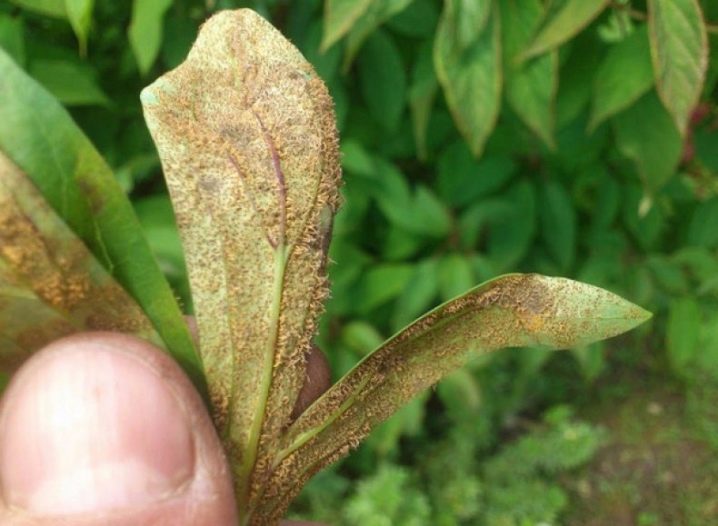
Gray rot
It affects all parts of the plant, from the roots to the apical shoots. Diseased peonies are easy to identify with the arrival of spring, young stems are covered with brown seals. Spots are visible at the base of the shoots and gradually merge into one ring. Gray rot causes rotting of plant tissues, leading to wilting of buds, leaves and death of the bush. It also spreads to the substrate, causing sclerotia.
It takes 3 days for gray mold to develop. In the absence of treatment and preventive action, the tops completely spread over the ground, and the plant dies, eaten by the spores of the fungus. At this stage, the disease passes to the rhizome of the dead peony. The fungus is very tenacious, easily tolerated by insects and wind.
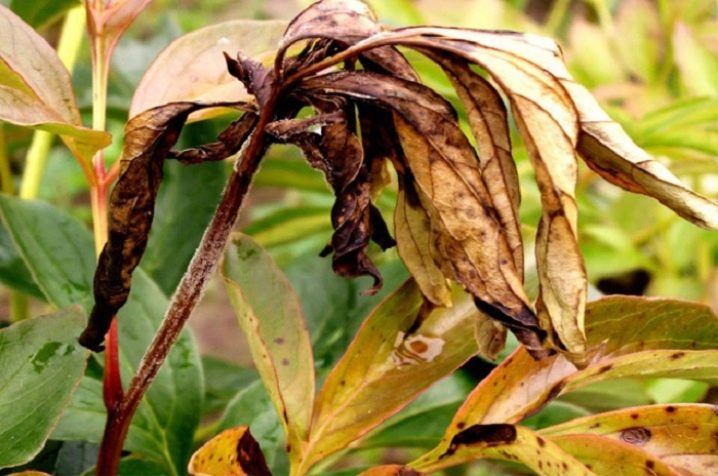
Cladosporium
Brown spots formed on the tops of the plant. As they ripen, they turn purple. Over time, the infected areas grow, completely covering the leaf plate, then darken. The leaf dries up. In wet weather, the inside of the leaf is covered with a bloom, which contains the spores of the fungus.

Septoriasis
It affects all parts of the culture, the manifestation of the disease is noticeable in the middle of the summer season.Both sides of the leaf plate are strewn with seals, spots, swellings of a yellow, brown or brown tone. A characteristic feature of the spots is a light middle, a purple border. The bulges grow, unite and change color to brown with a grayish-blue tint. Septoriosis first appears on the lower leaf plates of the peony, gradually moving upward. Severely damaged leaves dry out, but do not fall off.
The disease reduces the ability of the plant to survive low temperatures, causes defects in buds.

Phylostictosis
Round brownish spots with purple edging cover the inside of the leaves. As the spots mature, the spots brighten, increase in size, the fruiting bodies of the fungus appear through the tissues of the leaf plate in the form of dark inclusions of a convex shape. As a result, a rupture of the leaf plate occurs, the wound dries up. The main danger of phyllostictosis is cultural depletion. The fungus is in a dormant period in winter; with the onset of spring, it begins to infect the remaining parts of the plant.
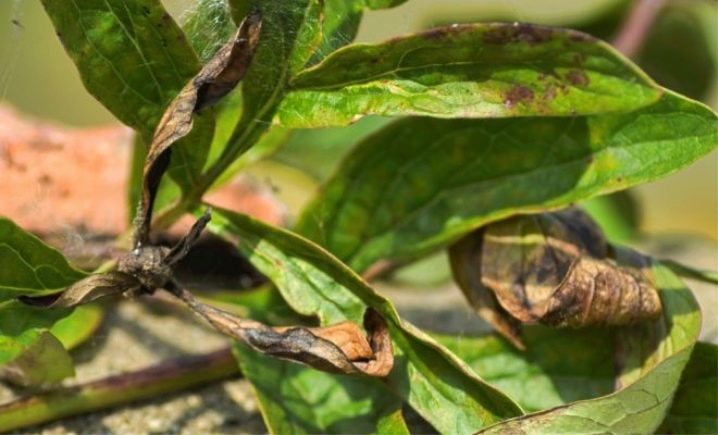
Root rot
It is easier to notice root rot during transplanting by dividing the bush. Infected areas are brown in color, soft to the touch, rot and die off over time. Finding peony bushes for a long time in a place with high humidity leads to the formation of a white, gray or pinkish bloom. The cause of the disease is waterlogging of the soil. The fungus develops rapidly in acidic soils.

Powdery mildew
External signs are the formation of a whitish coating on the outer sides of the leaf plates. Plaque is a mycelium with spores in it. Powdery mildew spores remain tenacious in places with low temperatures. They easily tolerate the dormant period of the plant.
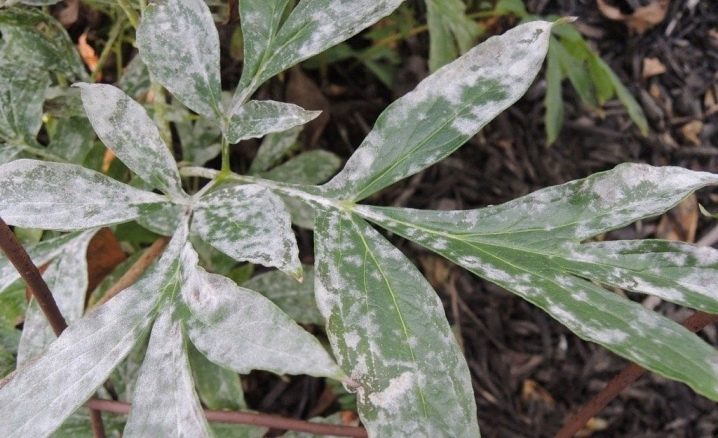
Verticillosis
The disease affects crops during the flowering period, deeply penetrating the tissues of the plant. Verticillary wilting is manifested by wilting, wilting of leaf plates and peony stems for no apparent reason. The culture turns yellow, dries up and dies. When the stem is cut, darkened vessels are easily visible. The fungus is resistant to low temperatures, hibernates, being in the root collar of the plant, its roots. Verticillosis can manifest itself a long time after planting peony bushes (after 2 years or more), which makes it difficult to diagnose and treat the plant.
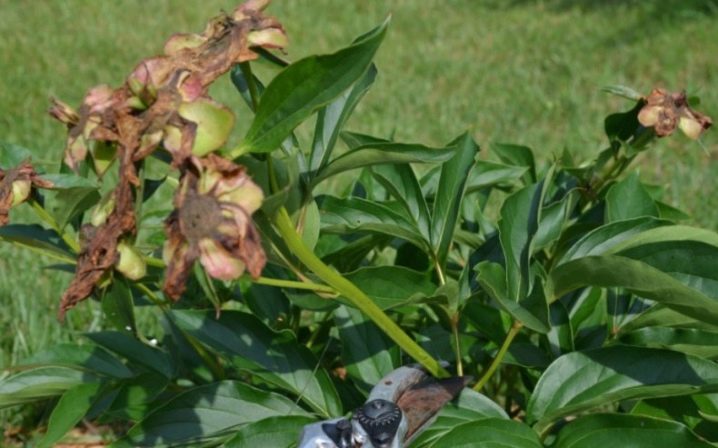
Ring mosaic
Partially affects the leaf plates in the early stages of the development of the disease, as a result of which it becomes difficult to identify the disease. Mosaic sign: stripes or concentric circles of light green, light yellow tones, which alternate with dark green areas. The shape of the pattern resembles a mosaic, from which the disease got its name. Over time, the infected areas form small necrotic areas.
As a preventive measure, the infected parts of the plant are removed up to the rhizome, followed by their burning.
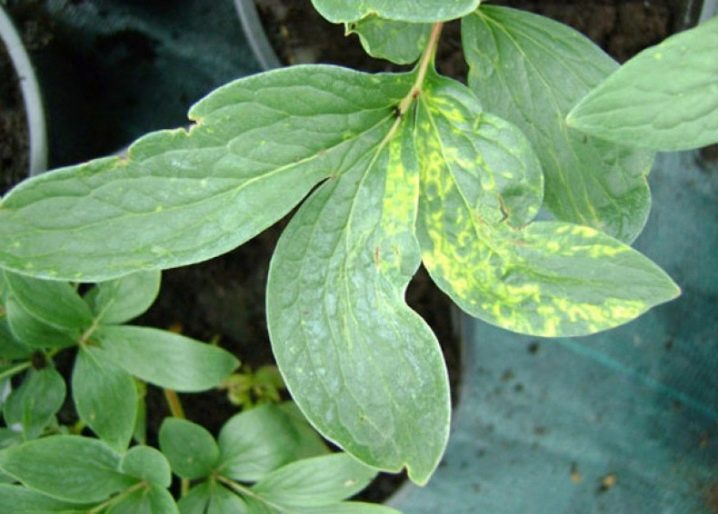
Lemoine's disease
There is no information that accurately describes the symptoms of Lemoine's disease, as well as the reasons for its occurrence. Symptoms are similar to those of a plant infection with nematodes. There is a version that root knot nematodes are carriers of the disease. The alleged symptoms of Lemoine's disease are as follows:
- violation of the growth and development of culture, shallowness;
- lack of flowering;
- bulges form on the root system.
Important! The disease can spread to nearby bushes. To avoid mass contamination, diseased cultures are completely removed from the site and burned.
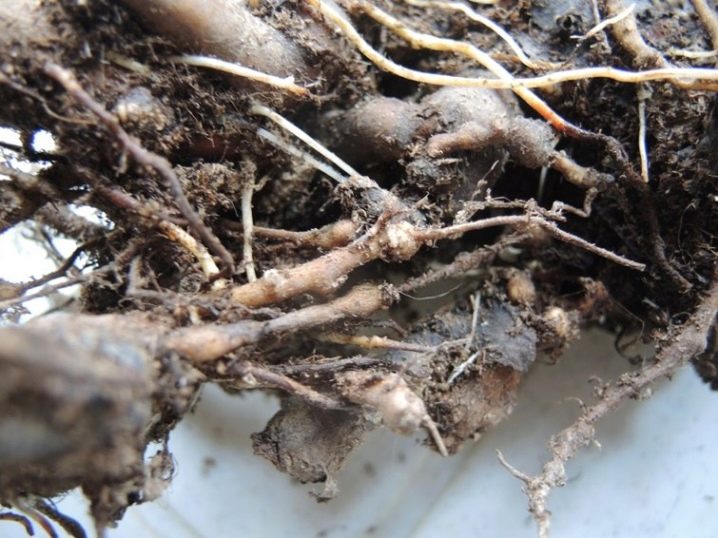
Pests
Among pests, peonies are most often affected by sucking insects and ants, but they suffer from them much less often when compared with fungal infections. If suspicious activity is detected on the bush, it is necessary to determine which type of pest has infected the plant in order to take the correct direction of treatment.
Aphid
Tiny greenish-white insects settle on the inner side of the leaf plate, apical shoots, at the base of the buds. Insects feed on the intercellular sap of the culture. With a massive colony of aphids, the plant withers quickly, the leaves curl, the buds do not bloom. In the fight against aphids, the use of a soap solution, spraying the culture with insecticidal preparations will help.
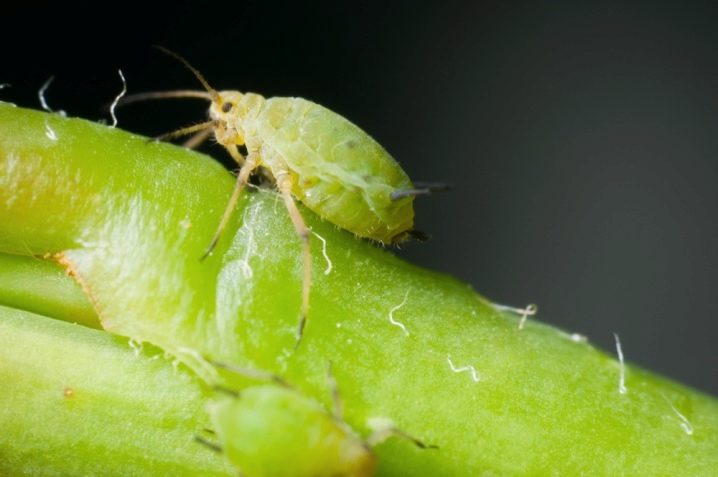
Bronze beetle
The insect is dangerous during the warm period, from May to the end of August. Beetles eat the soft parts of the plant: pistils, petals of buds, stamens, leaf plates. To combat bronze beetles, it is necessary to frequently loosen the upper layers of the soil at the end of the summer season. In summer, insects actively pupate. Loosening the substrate reduces the insect population and reduces the risk of infestation of the peonies. Collecting beetles every day gives positive results. It is recommended to use insecticides or infusion of tomato tops.
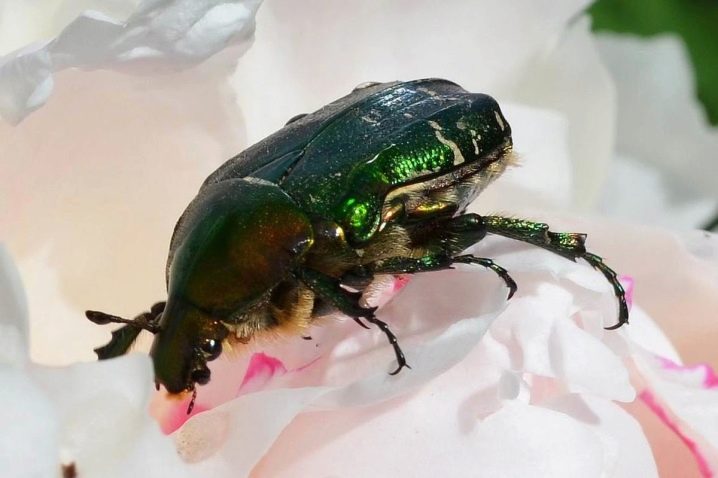
Gall nematodes
They cause wilting of the plant, leading to the complete death of the culture. Nematodes infect the root system, forming nodular formations, swelling. Fighting nematodes leads to the immediate burning of all affected plant parts. The ash must be treated with a 1% formalin solution. The earth around the peonies is dug up and fertilized with minerals.
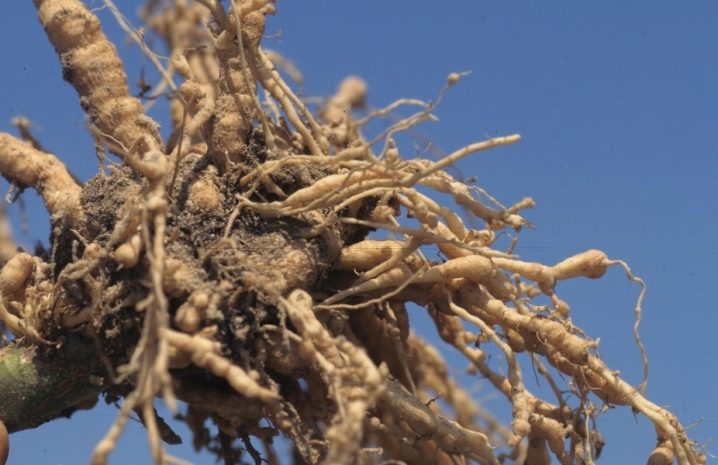
Ants
They feed on the sweet sap of peonies secreted by the stamens of the buds. Insects affect the soft tissues of the plant, petals, leaves. The bush loses its decorative effect and becomes more susceptible to infections. Repellents act against ants, spraying is done on the tops of the plant and the soil.

Thrips
Small insects that infect crops during the active growing season. They feed on intercellular sap, like aphids. Destroy the pest with dandelion infusion or special insecticides.
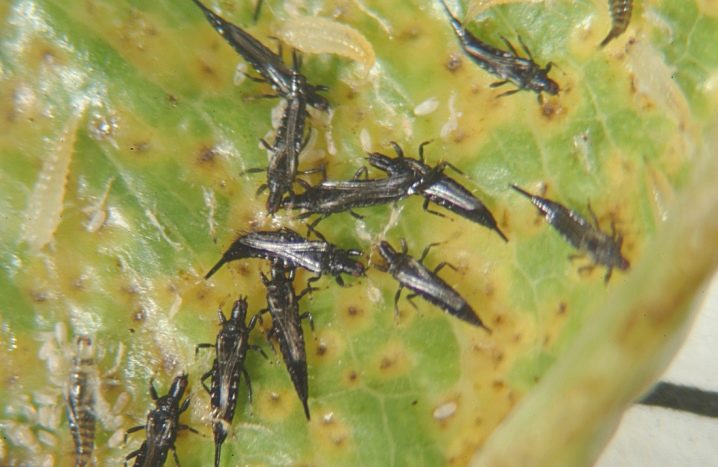
Hop thinworm
The insect larvae are dangerous, they feed on the roots of the plant. Damage to the root system reduces the growth rate of peonies, the plant is not able to lay flower buds, with extensive damage - death. Preventive actions are reduced to digging up the soil, removing weeds, pruning thickened plantings or using the Iskra preparation.

Treatment methods
In the initial stages of the disease, folk remedies can be used. Washing the culture with soap or garlic solution. The film formed on the parts of the plant, after the solution dries, does not allow insects to feed on the juice. Solutions based on tinctures of dandelions, nettles, tomato tops and so on work according to the same principle. For flying insects (whiteflies and others), gardeners are advised to use tobacco smoke.
After flowering, the upper layers of the substrate are loosened with its partial replacement with a new one. Be sure to feed the plants with nutrient minerals. Fertilizers help crops survive the winter, and weakened plants after illness to gain strength. And also loosening the earth helps to get rid of insect larvae. In case of mass infection of peony bushes with pests, it is worth using such special means as:
- insecticides - "Belt", "Decis Profi", "Proteus", "Calypso";
- fungicides - "Topaz", "Fundazol", "Maxim", "Skor", copper sulfate, Bordeaux mixture;
- fortifying drugs - "Epin", "Kornevin", "NV-101".
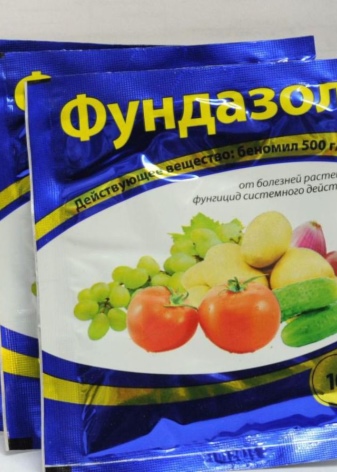
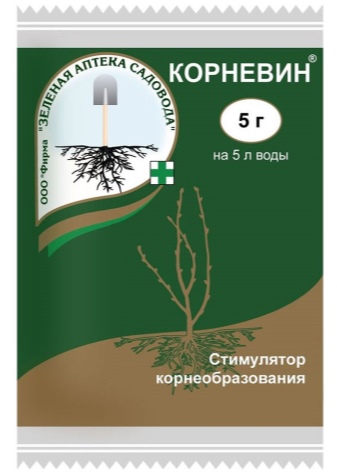
The fight against them comes down to the timely weekly treatment of the bushes with the selected drug in the morning and evening hours, observing all the requirements of the instructions. These active substances can harm bees and other beneficial insects. Before spraying, all infected areas must be removed from the plant and burned. After the procedure, treat hands, clothes, as there is a possibility of spreading spores of fungi, larvae.
If possible, infected crops should be fenced off from healthy plants by placing them in a kind of quarantine.

Prophylaxis
Timely preventive treatment allows the culture not to become infected with fungal infections, pests and other diseases. It is worth adhering to simple preventive measures.
- Every season or once every six months, it is recommended to loosen the top layer of the substrate, deoxidize the soil, and drain the area. It is recommended to add sand to heavy soil. Plants are planted keeping a distance of 30 cm from each other.
- In autumn, the site is cleaned from weeds, dead plant parts. All infected parts of the culture are burned, the affected areas are treated to healthy tissues, the wounds are covered with coal, and covered with resin.
- As a preventive measure, plants are sprayed with fungicidal and general tonic preparations, starting in the spring season. Peony bushes are regularly fed with nutritious fluids containing nitrogen, phosphorus, potassium.
- The disease is easier to prevent, do not forget to take care of plants and soil. Planting soil should be purchased in specialized stores or disinfected yourself.

For information on what methods exist for treating peonies from disease and harm, see the next video.







































































































The comment was sent successfully.